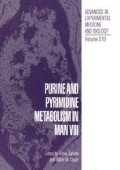Abstract
Humans with congenital homozygous deficiency of the purine degradative enzyme purine nucleoside Phosphorylase (PNP, E.C. 2.4.2.1) exhibit profound impairment in the T cell, but not B cell, arm of the immune system.1 Because of the importance of PNP in T cell development and/or function, it has been reasoned that PNP inhibitors might provide novel therapy for human disorders in which T cell function is central to the disease pathogenesis. Such an agent would, in theory, be B cell-sparing and relatively selective for replicating T cells, and hence non-inhibitory for quiescent (both memory and naive) T cells. After several years of pursuing this objective, we have identified a novel and highly potent inhibitor of PNP, CI-1000 (PD 141955-2; 2-amino-3,5-dihydro-7-(3-thienylmethyl)-4H-pyrrolo[3,2-d]-pyrimidin-4-one HCl; 9-deaza-9-(3-thienylmethyl)guanine; BCX-5*).2 The Ki of CI-1000 for human erythrocyte PNP is 67 nM,2 while the IC50 using calf spleen PNP is reported to be 80 nM.3 When tested concomitantly with 2’-deoxyguanosine (GdR), CI-1000 potently inhibits 3H-TdR uptake by MOLT-4 and CEM T cell lymphoblasts, but not B cell lymphoblasts,2’4 produces concentration-dependent inhibition of the human mixed lymphocyte reaction (MLR),5 and dose-dependently elevates dGTP both in T lymphoblasts and in the MLR.2, 4, 5 CI-1000 also exerts potent growth inhibition of the human cutaneous T cell lymphoma cell line MyLa via a mechanism that does not appear to involve accumulation of dGTP.6 In rats following oral administration, CI-1000 causes dose-related elevation of plasma nucleosides over the range of 0.5 to 150 mg/kg.2 Plasma inosine levels in rats following a single oral dose of CI-1000 approximate the lower levels found in PNP-deficient children, and persist despite declining CI-1000 concentrations in plasma.1, 2 When added to human or rat whole blood that had been spiked with GdR or inosine (HxR), CI-1000 markedly reduced the rate of purine nucleoside degradation compared with untreated whole blood.7 The studies described here were undertaken to determine the extent of activity of CI-1000 in a comparable system using whole blood from cynomolgus monkeys. Studies in monkeys were prompted by the need to construct an integrated hypothesis incorporating the pharmacokinetiq activity of CI-1000 with pharmacodynamic effect (nucleoside elevation) and toxicologic and immunotoxicologic findings in monkeys, so as to provide a model to assist in the evaluation of CI-1000 in human trials.
Access this chapter
Tax calculation will be finalised at checkout
Purchases are for personal use only
Preview
Unable to display preview. Download preview PDF.
References
N.M. Kredich and M.S. Hershfield, Immunodeficiency diseases caused by adenosine deaminase deficiency and purine nucleoside Phosphorylase deficiency, in: “The Metabolic Basis of Inherited Disease,” J.A. Stanbury, ed., 6th Edition, pp. 1045–1075, McGraw-Hill Information Services Company, New York, (1989).
R.B. Gilbertsen, U. Josyula, J.C. Sircar, M.K. Dong, W. Wu, D.J. Wilburn, and M.C. Conroy, Comparative in vitro and in vivo activities of two 9-deazaguanine analog inhibitors of purine nucleoside Phosphorylase, CI-972 and PD 141955, Biochem. Pharm. 44:996 (1992).
S.E. Ealick, Y.S. Babu, C.E. Bugg, M.D. Erion, W.C. Guida, J.A. Montgomery, and J.A. Secrist, III, Application of crystallographic and modeling methods in the design of purine nucleoside Phosphorylase inhibitors, Proc. Natl. Acad. Sci. USA 88:11540 (1991).
R.B. Gilbertsen, M.K. Dong, U. Josyula, J.C. Sircar, D.J. Wilburn, and M.C. Conroy, Activities of two 9-deazaguanine analog inhibitors of purine nucleoside Phosphorylase, CI-972 and PD 141955, in vitro and in vivo, Annals New York Acad. Sci. 685:248 (1993).
D.J. Wilburn, M.K. Dong, and R.B. Gilbertsen, PD 141955 and CI-972: 9-deazaguanine analog inhibitors of purine nucleoside Phosphorylase (PNP). I. Suppression of the human mixed lymphocyte reaction (MLR), Agents and Actions 39:C96 (1993).
W-H Boehncke, R.B. Gilbertsen, J. Hemmer, and W. Sterry, Evidence for a pathway indcpendent from 2’-deoxyguanosine and reversible by IL-2 by which purine nucleoside Phosphorylase inhibitors block T cell proliferation, Scand. J. Immunol. 39: 327 (1994).
M.K. Dong and R.B. Gilbertsen, PD 141955 and CI-972: 9-deazaguanine analog inhibitors of purine nucleoside Phosphorylase (PNP). II. Effects on nucleoside catabolism in human and rat blood in vitro, Agents and Actions 39: C99 (1993).
R.B. Gilbertsen and M.K. Dong, Effects of 8-aminoguanosine, an inhibitor of purine nucleoside Phosphorylase, on plasma nucleosides in Wistar rats, Annals New YorkAcad. Sci. 451: 313 (1985).
R.B. Gilbertsen, M.K. Dong, and L.M. Kossarek, Aspects of the purine nucleoside Phosphorylase (PNP) deficient state produced in normal rats following oral administration of 8-amino-9-(2-thienylmethyl)guanine (PD 119, 229), a novel inhibitor of purine nucleoside Phosphorylase, Agents and Actions 22: 379 (1987).
R.B. Gilbertsen, M.K. Dong, L.M. Kossarek, J.C. Sircar, C.R. Kostlan, and M.C. Conroy, Selective in vitro inhibition of human MOLT-4 T lymphoblasts by the novel purine nucleoside Phosphorylase inhibitor, CI-972, Biochem. Biophys. Res. Comm. 778: 1351 (1991).
J.C. Sircar, C.R. Kostlan, R.B. Gilbertsen, M.K. Bennett, M.K. Dong, and W.J. Cetenko, Inhibitors of human purine nucleoside Phosphorylase. Synthesis of pyrrolo[3,2-d]pyrimidines, a new class of purine nucleoside Phosphorylase inhibitors as potentially T-cell selective immunosuppressive agents. Description of 2,6-diamino-3,5-dihydro-7-(3-thienylmethyl)-4H-pyrrolo[3,2-d]pyrimidin-4-one, J. Med. Chem. 35: 1605 (1992).
Author information
Authors and Affiliations
Editor information
Editors and Affiliations
Rights and permissions
Copyright information
© 1995 Springer Science+Business Media New York
About this chapter
Cite this chapter
Gilbertsen, R.B., Dong, M.K. (1995). Blockade of Nucleoside Degradation in Monkey Whole Blood in Vitro by CI-1000, a Purine Nucleoside Phosphorylase (PNP) Inhibitor. In: Sahota, A., Taylor, M.W. (eds) Purine and Pyrimidine Metabolism in Man VIII. Advances in Experimental Medicine and Biology, vol 370. Springer, Boston, MA. https://doi.org/10.1007/978-1-4615-2584-4_37
Download citation
DOI: https://doi.org/10.1007/978-1-4615-2584-4_37
Publisher Name: Springer, Boston, MA
Print ISBN: 978-1-4613-6105-3
Online ISBN: 978-1-4615-2584-4
eBook Packages: Springer Book Archive

